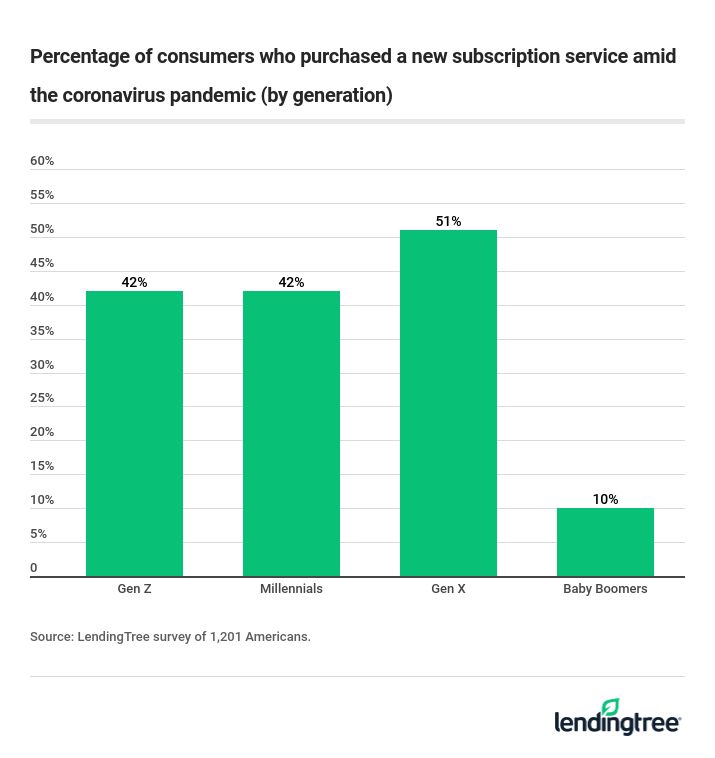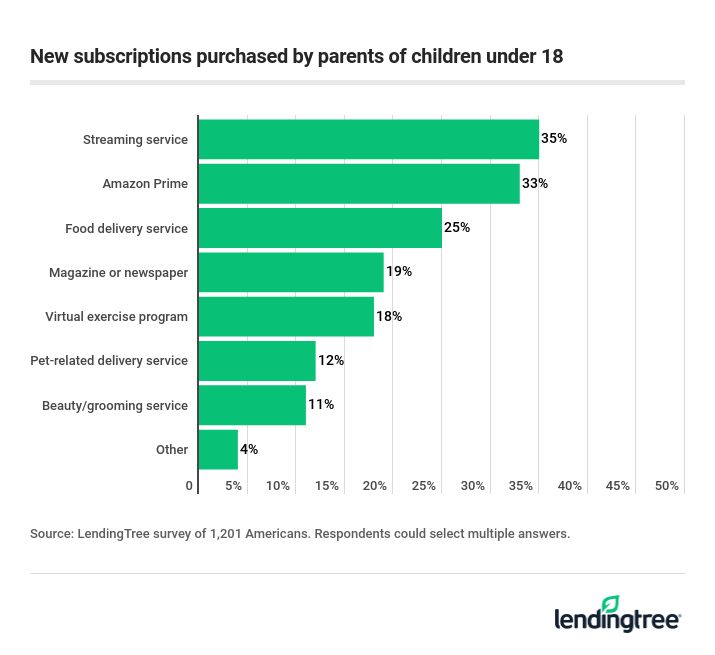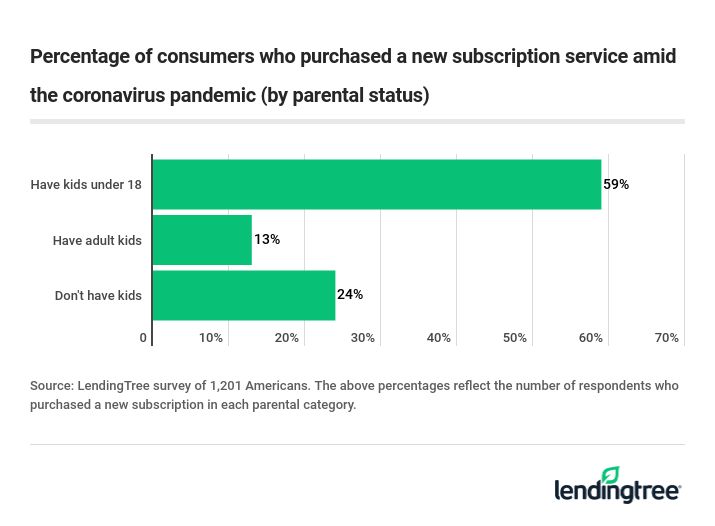Many Americans More Than Tripled Subscription Service Spending Amid Social Distancing
The coronavirus pandemic has drastically altered the way Americans spend money. In many cases, that has meant cutting back — but one area where many consumers are spending more is on subscription services.
A recent LendingTree survey found that 1 in 3 respondents had purchased a new online subscription as they sheltered at home to reduce the spread of the virus as well as to entertain children after schools have closed.
Key findings
- 1 in 3 consumers have purchased a new online subscription as a direct result of coronavirus-related circumstances, such as being stuck at home or for child-friendly entertainment.
- The top five most popular new subscriptions include streaming services like Netflix or Hulu (17%), Amazon Prime (15%), food/delivery services, such as Instacart (12%), magazines and newspapers (8%) and virtual exercise programs (8%).
- Amazon Prime was most popular among Gen Xers (27% recently signed up).
- A quarter of parents with young children at home signed up for a food delivery service.
- 35% of parents with young kids and 31% of Gen Xers signed up for a new streaming service.
- On average, consumers spent $192.30 on these new subscription services, and while some may be a one-time or annual fee (like Amazon Prime), many of the costs will recur monthly.
- A March survey from LendingTree found the average American spends slightly more than $50 per month on subscriptions, so this is a significant increase.
- The two biggest reasons Americans subscribed to new products or services are to entertain themselves (67%) and to entertain their children (41%) while stuck at home. Another big factor was to reduce having to leave the house to purchase necessities (39%), and 18% wanted to support businesses during this time of economic uncertainty.
- Gen Zers (22%) were most likely to be motivated by the prospects of supporting businesses, while millennials (43%) were strongly pushed by not wanting to leave the house to purchase necessities.
- Nearly 60% of parents of children under 18 purchased a new subscription. Gen Xers (51%) even beat out millennials (42%) for new subscription purchases, though millennials are spending the most at more than $300 on average.
Streaming subscriptions booming as people stay at home
Of those who purchased a new subscription, 67% said the main reason they did so was for entertainment, and 41% said the main reason was to entertain their children.
As might be expected, streaming subscriptions have seen a wave of sign-ups as people look for ways to fill their time for themselves and their families without having to come in contact with the outside world. For example, Netflix added 15.8 million subscribers in the first quarter of 2020, according to a letter to shareholders. And according to an April article in The Guardian, Disney+ almost doubled its subscriptions between February and April, hitting 50 million subscribers.

“Even though we aren’t leaving the house, people need to be entertained,” said Matt Schulz, chief consumer finance analyst at LendingTree. “They want to see new shows, eat interesting new foods, feel the rush of a good workout. Without those, this difficult time would be far worse.”
Streaming services proved to be a popular choice for a new subscription among most age groups, but members of Gen X were far more likely to sign up for a streaming subscription than other demographics. Among Gen X respondents, 31% of consumers had added a streaming subscription, compared with 22% of millennials and 17% of respondents in Gen Z.
Consumers’ subscriptions helped reduce trips outside
When asked to select why they signed up for a new subscription, 39% of respondents said that they did so to reduce having to leave the house to purchase necessities. Millennials led the pack with 43% saying so.
This seems to correlate with why Amazon Prime and food/delivery services were among the most popular new subscriptions. And of all age groups, members of Gen X were most likely to subscribe to these services (27% for Amazon Prime and 20% for food/delivery), followed by millennials (19% for Amazon Prime and 16% for food/delivery).
Another popular reason cited was to support businesses during this period of economic uncertainty caused by the COVID-19 pandemic. This was most popular among members of Gen Z, with 22% saying so.
Parents most likely to sign up for streaming, food delivery services
With rampant school and day care closures, it’s no surprise that 41% of survey respondents who got a new subscription said the main reason they signed up was to entertain their children. Nearly 60% of those who are parents of children under 18 years old purchased a new subscription of some kind.


The three most popular new subscriptions reported for parents were as follows:
- A streaming service (35%)
- Amazon Prime (33%)
- A food/delivery service (25%)
For all of these services, parents were more likely than the average respondent to sign up. Here’s what the overall numbers looked like:
- A streaming service (17%)
- Amazon Prime (15%)
- A food/delivery service (12%)
“As a parent, I can tell you that streaming services have been absolutely essential,” Schulz said. “While most parents don’t want their kid sitting around all day just watching screens, the reality is that a little screen time for kids can often free up parents to get other things done — or even just slip away for a moment of zen on a crazy day.”
How to avoid overspending on subscriptions
The average amount consumers reported spending on new subscriptions due to coronavirus-related circumstances was $192.30. Millennials led all age groups, spending an average of $315.90 on new subscription services. This represents a significant increase over normal spending, considering that a LendingTree survey from March 2020 found that the average American spends just over $50 per month on subscriptions.
Baby boomers spent the least on new subscriptions, at an average of $43.40.
If you’re thinking about adding a subscription, evaluate what your spending patterns look like right now. For example, staying at home more might mean you’re saving on gas, but spending more on utilities. And if you’re cooking more at home rather than dining out at restaurants, that could mean savings on dining but more spent on buying groceries.
“When deciding whether to subscribe, remember your budget,” Schulz said. “That new streaming service may have all the buzzworthy shows that people are talking about, but if you’re wondering where your next paycheck will come from, you may need to pass.”
Methodology
LendingTree commissioned Qualtrics to conduct an online survey of 1,201 Americans, with the sample base proportioned to represent the overall population. The survey was fielded April 3-6, 2020.
Generations are defined as the following ages in 2020:
- Gen Z are ages 18-23
- Millennials are ages 24-39
- Gen X are ages 40-54
- Baby boomers are ages 55-74
- Silent generation are ages 75 and older
The content above is not provided by any issuer. Any opinions expressed are those of LendingTree alone and have not been reviewed, approved, or otherwise endorsed by any issuer. The offers and/or promotions mentioned above may have changed, expired, or are no longer available. Check the issuer's website for more details.
